For decades critics have written disapprovingly about the relationship between the market and art. In the 1970s proponents of institutional critique wrote in Artforum about the degrading effects of money on art, and in the 1980s Robert Hughes (author of Shock of the New and director of The Mona Lisa Curse) compared the deleterious effect of the market on art to that of strip-mining on nature.1 More recently, Hal Foster has disparaged the work of some of the markets hottest art stars—Takashi Murakami, Damien Hirst, and Jeff Koons—declaring that their pop concoctions lack tension, critical distance, and irony, offering little more than “giddy delight, weary despair, or a manic-depressive cocktail of the two.”2 And Walter Robinson has spoken about the ability of the market to act as a kind of necromancer, reanimating mid-century styles of abstract painting for the purposes of flipping canvas like real estate—a phenomenon he calls “zombie formalism.”3
Moralistic attacks against the degrading impact of the market on art are not unique to US-based critics. Soon after the end of the Cultural Revolution, when few people think China had any art market at all, plainly worded attacks on commercialism appeared regularly in the nationally circulated art press. As early as 1979, Jiang Feng, the chair of the Chinese Artists Association, worried in writing that ink painters were churning out inferior works in pursuit of material gain. 4 In 1983, the conservative critic Hai Yuan wrote that “owing to the opportunity for high profit margins, many painters working in oil or other mediums have switched to ink painting.” And, what was worse, to maximize their gain, these artists “sought to boost their productivity by acting like walking photocopy machines.”5 In the 1990s supporters of experimental oil painting also came under fire. After visiting the 1992 Guangzhou Biennial Art Fair, avant-garde art critic Li Xianting was reportedly so overcome by the potential dangers of commercialism that he wept.6 Other visitors were so upset by the contaminating effect of commerce that they sprayed the exhibition hall with Lysol to extinguish its stench. And a few months later, still others organized a mock funeral to mourn the death of artists that had succumbed to the fatal temptations of market exchange.
But for critics in China, unlike those in the West, the foreign identity of many of the buyers of contemporary art added to the sting, and for decades, nationalism, even xenophobia have inflected the debate. When Zhu Qi complained in 1999 that Westerners do not understand Chinese art and suggested that artists who pander to their tastes not only risk compromising their personal integrity but also their creative ability, many critics in the 1980s would have agreed, as they still might agree today.7
While the concerns of these important critics are certainly valid, it is also possible to argue the opposite: that in the context of China in the 1980s, the liberalization of the economy and the introduction of markets liberated artists from the strictures of the state, and created an alternative space, incipient yet real, unstable yet protean, from which emerged artistic experiments of great imagination and force. Among the artists who recognized the empowering potential of the market and its pitfalls was Wu Shanzhuan whose early work crystallizes the process I am trying to describe.
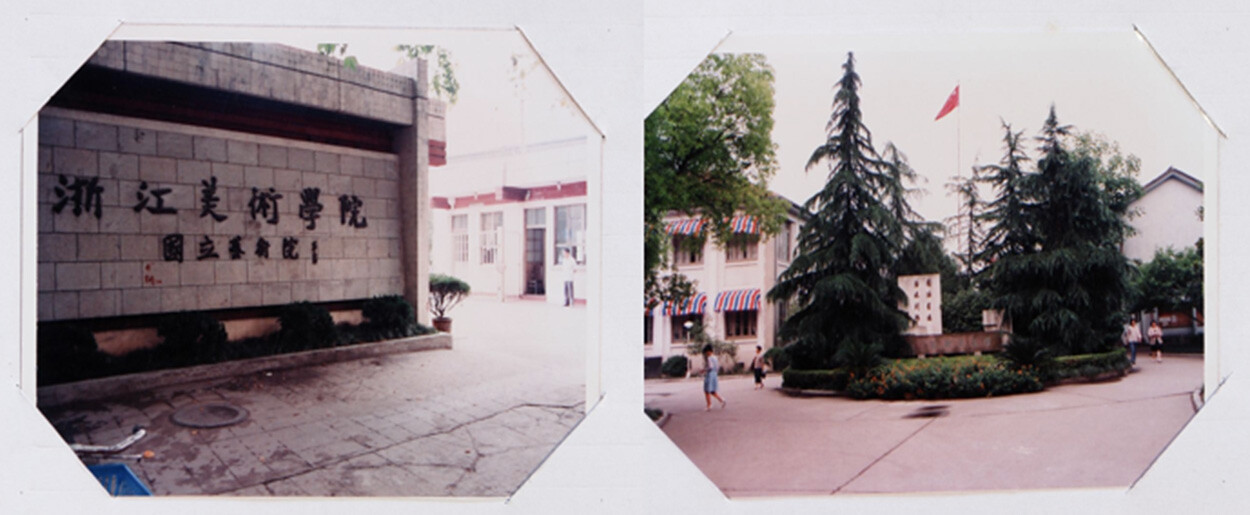

Two views of the Zhejiang Academy of Fine Arts in 1980, now the China Academy of Art. Courtesy of the artist and the China Academy of Art.
1. Big Business
For the three decades between 1949—when Mao Zedong declared the establishment of the People’s Republic of China—and 1979, when Deng Xiaoping and his allies in the government ousted the ultraleft Gang of Four and began reforming the economy—the dominant and singular system of support and control of Chinese art was the state. Artists were not only educated and employed by the state, in state-controlled schools, but they lived in state-owned housing and produced work in state-owned studios with allocated state-owned art supplies; work which was then displayed at state-organized exhibitions that took place in state-controlled venues. If they were lucky, their work might garner state-organized awards and be published in the state-controlled media.8
But starting in the late 1970s, China embarked on a series of far-reaching economic reforms. Beginning in the agricultural sector, these reforms were aimed at re-igniting a stalled economy and were defined by the appearance of a market, first in the countryside and soon after in towns and cities, where farmers and villagers alike sold produce and handmade products for prices determined by supply and demand, rather than state policy. By the mid-1980s these economic directives had expanded to include some of the large state-owned enterprises, from media concerns to manufacturers, who were encouraged to become financially accountable and to make a profit.
The state agencies in charge of cultural programs followed suit, organizing exhibitions at first of ink painting and later oil painting that were sent abroad, to Japan and the West, to develop diplomatic ties and to generate business opportunities. In an effort to accumulate foreign currency, shops selling paintings to an increasing influx of tourists proliferated all over China. Even the National Gallery expanded its retail initiatives, rented gallery space, and hosted sales exhibitions, like the series organized between 1986 and 1989 by the Beijing International Art Palace, a partnership between the Chinese government and a Japanese real estate developer. Headed by Liu Xun, a senior official of the Chinese Artists Association, the Art Palace held fifteen sales exhibitions at the National Gallery, until establishing its own gallery at the Holiday Inn Crown Plaza in Wangfujing in 1991. The pressure to generate income became so great that the National Gallery started rotating their exhibitions with almost unprecedented frequency. By 1988, it was presenting two-hundred shows a year, of which 95 percent lasted less than two weeks and many were only open for a few days.9 The museum had begun to resemble a commercial gallery, and the largest percentage of work displayed in these short-term shows was ink painting. Ink painting was the most commercially viable form of art at the time, and, despite the hype around the handful of oil paintings that achieve six or seven figure prices, ink painting still accounts for the largest segment of the domestic Chinese art market today.10
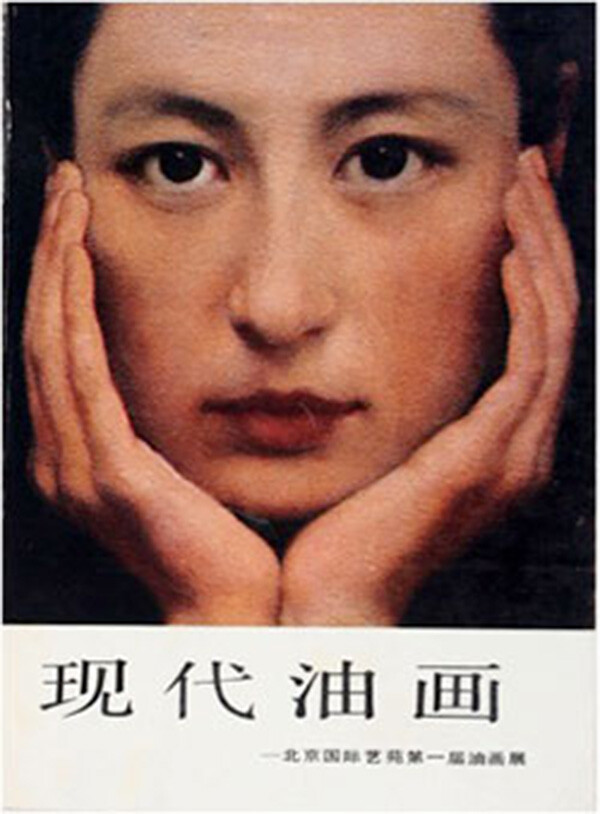

Cover of Xiandai youhua: Beijing guoji yiyuan diyijie youhuazhan, the catalogue for the First Beijing International Art Palace Oil Painting Exhibition (1986). Cover image: Wang Yidong.
An exception to this preference for ink was the “Nude Oil Painting Exhibition,” one of the most popular and profitable shows in the history of the National Gallery, which ran for a mere eighteen days from December 22, 1988 to January 8, 1989. “The nude art show,” writes Richard Kraus writes in The Party and the Arty in China, “created a sensation even before it was opened. As early as June, forty-seven Chinese newspapers and seven foreign news services carried reports on the coming show. The unprecedented exhibit attracted about a quarter of a million visitors in eighteen days.”11 Taking advantage of its immense popularity, the cost of admission was increased ten times, from the usual two mao to two yuan, and fully illustrated catalogues were sold (and sold out) for the then-exorbitant price of forty-five yuan.12
But it wasn’t just fee-hungry museum administrators and organizers with overtly commercial goals who saw the possibilities inherent in the newly emerging space between the state and the market. Champions of experimentalism saw it, too. In 1985, after three years of effort, Robert Rauschenberg succeeded in procuring gallery space at the National Gallery from the Chinese International Exhibition Agency, an arm of the Ministry of Culture, to produce an installment of the Rauschenberg Overseas Culture Interchange. Gao Minglu, the indefatigable advocate of the Chinese avant-garde, was one of the purported 300,000 people who came to see Rauschenberg’s show.13 He would go on to rent the National Gallery himself after raising funds from several sponsors, including a fast food entrepreneur named Song Wei, in order to present the now infamous “China/Avant-Garde Exhibition” in 1989.14 And it was here that the market imaginary for Chinese contemporary artists finally stepped out onto center stage.
2. Selling Shrimps
“What mattered that day was not the art,” remembers the artist Zhang Peili, “or the show itself”—which anyway “looked more like a farmer’s market” than a typical art exhibition. “Everyone knew that they were making history. We were totally invested in our roles as actors on a stage where anybody could suddenly become a star.”15 One of the stars of this grand art bazaar was Wu Shanzhuan, who brought thirty kilograms of raw shrimp from his hometown of Zhoushan (Shanghai) to the National Gallery. There he set up shop by erecting a makeshift sign board, on which he wrote the following message:
Dear Customers:
As our entire nation celebrates the Year of the Snake, in order to enrich the spiritual and material life of the people of our nation’s capital, I have brought from my hometown of Zhoushan the highest-quality export shrimp (to be sold to the domestic market). Venue of display and sale: National Gallery of Art. Price: 9.5 yuan per catty. Hurry while supplies last.16
On the day of the opening, visitors to the museum crowded around Wu’s makeshift market stall to buy the frozen blocks of shrimps. Business was brisk, and Liu Kaiqu, the director of the National Gallery, was one of Wu’s first customers.17 However, the exhibition had only been open for half an hour when two plainclothes policemen ordered Wu to stop and took him away. A little while later, the artist returned to the exhibition hall to write on his chalkboard: “temporarily closed for stocktaking.”18
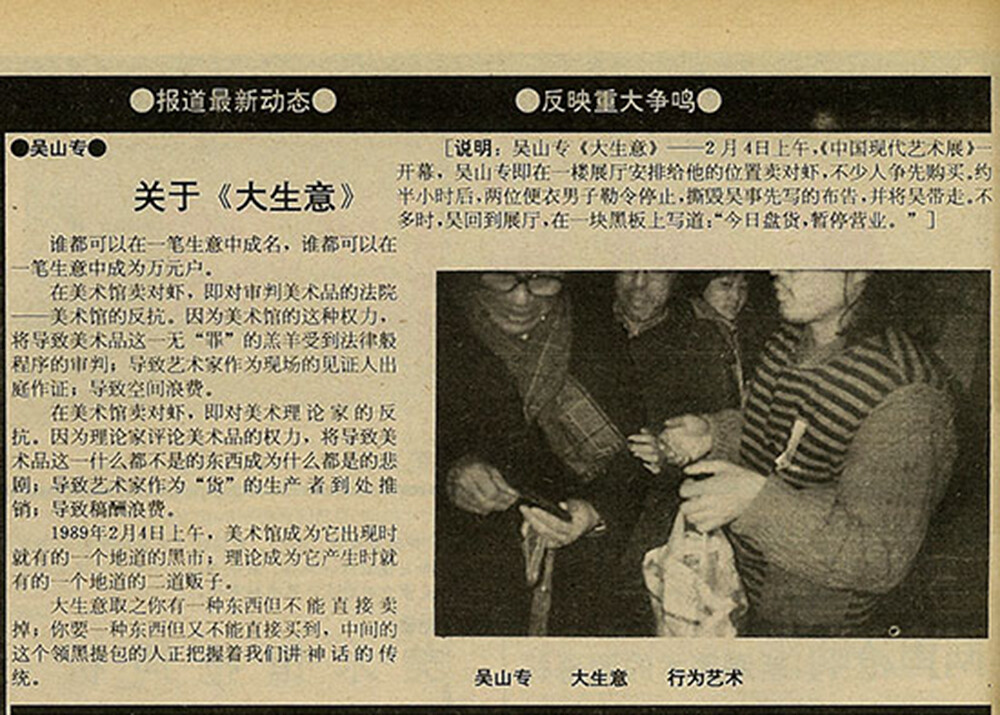

Page two of Zhongguo meishubao no. 11 (1989), with an article by Wu Shanzhuan and an image of Liu Kaiqu, director of NAMOC, buying shrimps from Wu’s market stall. Wu Shanzhuan archive at Asia Art Archive, Hong Kong. Courtesy of the artist.
Wu Shanzhuan’s deceptively straightforward performance has been interpreted in a number of ways. Gao Minglu wrote that Wu’s actions were a “rebellion against the art museum and art critics.”19 Some of Wu’s own writings support this interpretation:
Selling shrimps in the National [Art] Gallery is a protest against the court that judges artworks: the art museum itself. The authority of the art museum subjects art—an “innocent lamb”—to a trial conducted according to a quasi-legal process, as well as subjecting artists to the process of testifying as eye witnesses, resulting in a waste of good space.
Selling shrimps is also a protest against art critics, as their dominance of the critique of art will end in the tragedy of turning art from nothing into everything, and turning artists into salesmen who peddle the “goods” they produce, resulting in a waste of good money (referring to the commission fees paid to these theorists).20
Dissatisfaction with state-controlled institutions of art was widespread at the time, and another artist to voice his disdain was Huang Yongping, who conducted a series of provocative performances, including the display of junk inside a museum and the incineration of artworks outside of it.21 In a more muted yet equally pointed work, Huang extended his assault on the art institution by submitting a proposal to the “China/Avant-GardeExhibition” in which he planned to attach up to four thousand meters of rope to sixty locations on the façade of the National Gallery, in order to pull the building away from its site.22 By trapping it like a whale in a large fishing net, Huang sought to subdue the behemoth, dislodging the museum from its position of authority, and exposing not only the depth of its structural supports but also its vulnerability.
One of Geng Jianyi’s submissions to the “China/Avant-GardeExhibition” targeted the bureaucratic tendency of many of the participants, including the aspiring avant-garde organizers. Prompted by the blizzard of official-looking notices and forms issued by Gao Minglu and his organizational team, Geng disseminated his own mock registration form which he asked the unwitting recipients to fill out. These deceptively official but ultimately useless forms not only exposed the eager willingness of the organizers to adapt to official protocols, but also reflected the conformist impulses of aspiring artists equally eager to comply with any authority in hopes of gaining acceptance. Huang Yongping, however, saw through the ruse, as did Wu Shanzhuan, who responded with tongue in cheek. Many others, however, answered Geng’s forms in earnest.23
Art-institutional critique was perhaps a common lens through which many local Chinese art critics viewed the work of the avant-garde, and Wu’s work in particular, but other critics (often foreign) focused on its political and economic context. Norman Bryson, for example, writing in a later moment, saw Wu’s performance as a rebellion against the state: “Selling Shrimps was all about restriction,” he wrote, revealing “that behind the museum and behind even big business, lay the iron hand of the state.”24 Geremie Barmé, on the other hand, has noted that Wu’s conflation of the museum with the marketplace revealed that the National Gallery, which, he said, was making its halls “available to virtually any self-styled avant-garde who can afford the rental fee,” was not so much controlled by socialist dogma as it was by the dollar bill.25 Wu’s writings, always arcane, could support this interpretation as well:
On the morning of February 4, 1989, the art museum became every bit the black market that it was when the museum was built, where the theories produced there could be resold in the secondary market.
With big business, you have something to sell but you cannot just go out and sell it: you want to buy something but you cannot just go out and buy it. There is always this man in the middle toting a black briefcase and controlling our myth-making traditions.26
Wu would strenuously resist any attempt to put too fine a point on his comments. He’s more philosopher than political economist, and would probably not want his words to be attached to a specific current event or even historical moment. Still, Wu’s equation between the ecology of the art system and big business was prescient. Early on Wu identified 1987 as the year that the Chinese masses, including the intellectual class of which artists were a part, accepted business as integral to their new way of life. And in 1988, at an important art world conference, he declared, “Although some Chinese intellectuals tried to escape from this commercialism, da shengyi (big business) has become an affair of all Chinese citizens.”27 The Shanghai artist Yu Youhan must have noticed a similar tendency when also in 1988 he painted a set of pop-inspired renminbi.
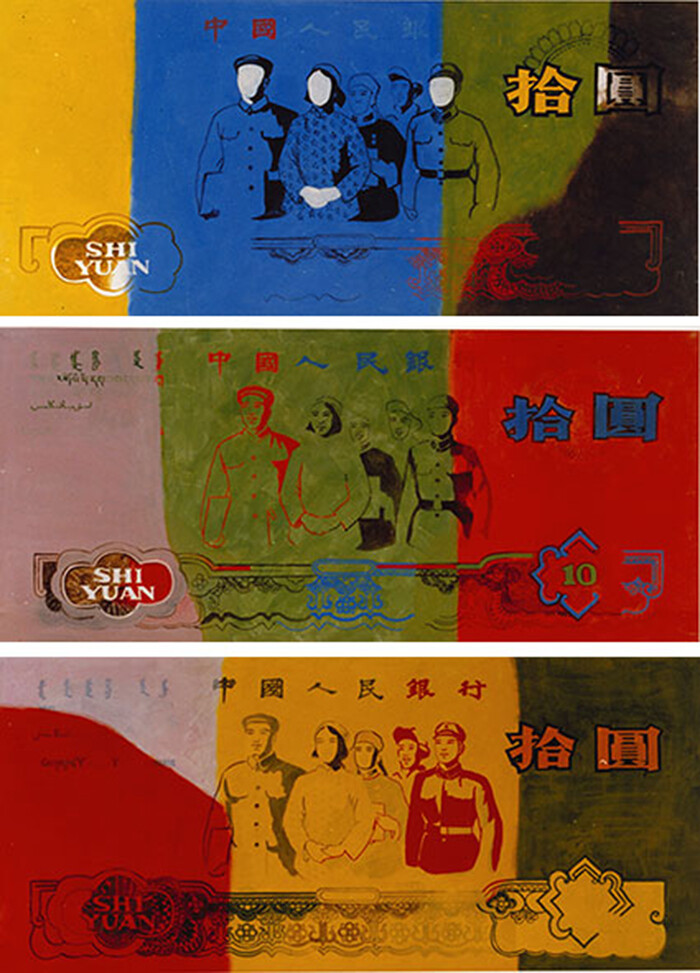

Yu Youhan, Renminbi, 1988. Oil on canvas. Photo: Carl Brunn. Courtesy of the artist and Ludwig Forum Aachen, collection Ludwig.
Like many of his contemporaries, Wu’s work was about exposing boundaries and breaking taboos, and the question of what precisely constitutes business provided a tantalizing new field of conceptual inquiry. Wu and his close family members had long been involved in enterprise in one form or another. Wu’s father was an amateur inventor who was constantly dreaming up new ways to try and make money.Wu also tried his own hand at business by selling fish in his hometown of Zhoushan. “The 1980s,” he explained, “was the time of the middleman in business, and I sold fish.”28 Selling Shrimps, in fact, was inspired by the concept of the middleman—the broker who negotiated, mediated, and facilitated exchange—and whose flexibility and pragmatism offered a refreshing alternative to the ponderous strictures of an economy that had been, until recently, entirely centrally planned. People were selling everything, Wu recalled, from shrimps and fish to pots and pianos, and so he began to think of art in that way, although, he said, it was not really that way at the time.29 And while Wu’s performance involved “selling shrimps in the name of art,” as he would later write in his “Alphabetical Aphorisms,” fully intended to make a profit from his performance.30 If he had not been stopped by the police, Wu remembered, he would have earned the equivalent of $200. But his shrimps were ruined, so he made no money. Wu’s “business in the name of art” had faltered, with the result that he had to borrow from a friend to pay for his train ticket home.31
3. To Buy Is to Create
In the context of the contemporary debate about the market and the state, Wu was the middleman in art and in business. By exploiting their intersection and making it the subject of his work, he erected a special “zone of art,” as Norman Bryson has written, where neither the rules of the state nor of the capitalist market fully applied.32 “It was the time of grey money,” Wu said.While all salaries were much the same in the early 1980s, by mid-decade the ability to make “grey” money became increasingly important, which Wu claimed ultimately was one of the reasons for the Tiananmen Square incident. “The economy was booming. There was grey money everywhere.”33 But, as Wu explained, grey money led to grey thinking,people called for democracy, and things went too far; that was when the government cracked down.34
Yet it was in this shifting landscape that making money became a new ideology. Wu even celebrated money’s allure by putting it in a commemorative frame. Exposing the new paradigm of exposure and support that emerged in the hybrid space between state and market, Wu made the dynamic middle zone the very subject of his investigation. The museum had become a marketplace and as such the marketplace had assumed the sanctity of the museum. As Wu would later say, “To buy is to create.”Straddling the fault lines between political and economic cultures, between ideology and materialism, Wu gave form to a new imaginary, exposing art’s newest source of energy.
Four months after the conclusion of the “China/Avant-Garde Exhibition,” government tanks and military trucks rolled through the streets of Beijing and into Tiananmen Square, leaving dead and injured a still-unknown number of unarmed citizens who had joined a massive anticorruption, pro-democracy demonstration. The impact of this event on the arts was swift. The number of exhibitions presented at the National Gallery in the following six months dropped about 40 percent from the year before. Art publications were censored or shut down. Curators and editors were demoted or reassigned. Champions of experimentalism in the arts, including their right-wing protectors within the political establishment, had lost the struggle for greater social and cultural freedoms. The state-sponsored institutional system made up of national museums, national exhibitions, national awards, and national media platforms was once again off limits to the experimental fringe. The conservative left wing had won.35
But the empowering potential of market reform identified by Wu and his compatriots did not falter. If, in the 1980s, the market for art had become an imaginary offering artists and their advocates the prospect of an alternative space of legitimization and support, in the aftermath of the Tiananmen crisis, the market was not just an imaginary. It had become an imperative, at least for some. Responding to the institutional intolerance for experimental art that characterized the 1990s, certain enterprising artists and their entrepreneurial champions began to embrace the art market as a possible solution to their professional constraints. Exemplifying this trend were the Guangzhou Biennial Art Fair organized by Lü Peng in 1992, and the early career of artist Wang Guangyi. Bearing further witness to the enabling role of commerce are the curatorial projects of Chang Tsong-zung whose gallery Hanart in 1993 organized the seminal exhibition Post-1989: New Art from China.
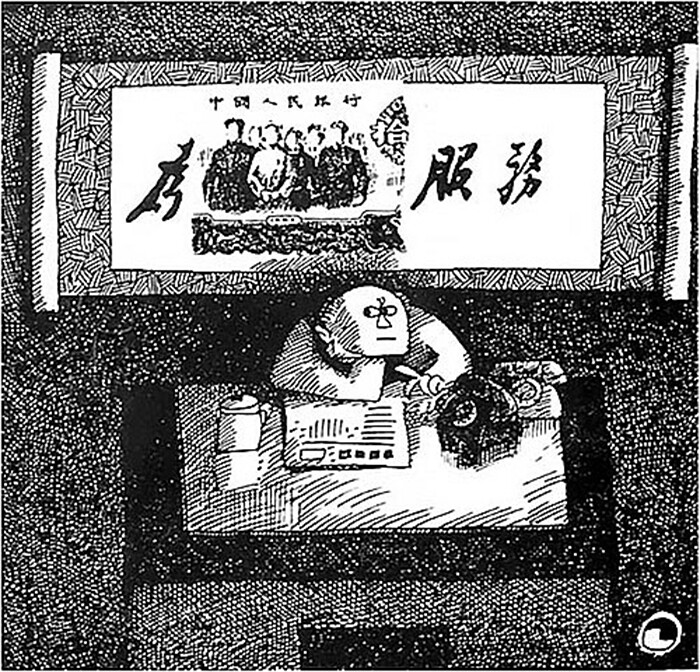

Zhang Liang, Serve the Renminbi, published in Beijing Review 32, no. 2 (January 9–15, 1989): 35.
4. Between State and Market
Today, the tables may have turned again. Given the accelerated pace of economic development in China over the last twenty years, could artists in the 1980s and early ’90s have foreseen that the means by which they sought independence from the instrumentalism of the state would itself become a trap? Could they have imagined that the promise of the market to deliver them from the suffocating authority of the government-controlled agencies would become a new and equally prescriptive authority?
It is tempting to attribute certain deleterious trends to the introduction of the art market. These trends, as prevalent is the West as they are in China, include the development of signature styles and the widespread repetition of stereotypical images. It is also tempting to blame the market for encouraging artists to remain within the safety of successful formulas at the expense of risky experimentation. But in the late 1980s and early ’90s, the market in China had the potential not only to corrupt but also to liberate, helping artists to reposition themselves and redefine their possibilities. Commenting on the proliferation of privately funded art exhibitions in Beijing in the 1980s, Nicholas Jose observed that “behind entrepreneurship lay the desire to achieve a new self-determination and self-identity.”36
Nonetheless, the precipitous rise in prices since 2000 for Chinese contemporary art in the international art market, combined with the dearth in China of durable independent platforms of visibility and debate, raises urgent questions. Commenting on the current situation whereby quality seems to have become synonymous with fashion, and value is determined primarily by monetary results, Martina Köppel-Yang has asked, “How can tautology be avoided? How can individuals and local positions be articulated without being swallowed, reproduced, and assimilated by national and global thought, and by the culture industries? Can art refuse ideological models offered by the market?”37 The state system of support for the arts in post-Mao China was neither monolithic nor static, and neither is today’s art market. Instead, it is complex and evolving. And just as in the 1980s and early ’90s, today there continues to be artists and advocates who hold fast to the promise of self-determination by exploring the creative space between the state and the market, to resist the instrumentalism of both.
For Robert Hughes’s famous quote (“What strip mining is to nature the art market has become to culture”), see →
Hal Foster, “The Medium is the Market,” London Review of Books, October 9, 2008 →
Walter Robinson, “Flipping and the Rise of Zombie Formalism,” Artspace, April 3, 2014 →
Jiang Feng, “Guanyu Zhongguohua wenti de yifengxin” [A letter about the problem of Chinese painting], Meishu 12 (1979): 10–11.
Hai Yuan, “Jingti yishu shangpinghua de buzheng zhifeng” [Watch out for an incorrect tendency toward commercialization in the arts], Meishu no. 1 (1983): 42. Hai Yuan is probably a pen name and may be short for Qian Haiyuan.
Zhongguo: Bajiuhou-yishu [China: Post-’89 art], ed. Wang Lin (Hong Kong: Yishu chaoliu zazhishe, 1997), 92–93.
Zhu Qi, “Do Westerners Really Understand Chinese Avant Garde Art?,” in Chinese Art at the End of the Millennium: Chinese-art.com 1998–1999, ed. John Clark (Hong Kong: New Art Media Limited, 2000), 55–60.
The Gang of Four is described as “ultraleftist” because that is how the Chinese would have described the extreme conservatism and doctrinaire Maoism of this group. In contrast, many of the leadership figures who advocated for a more liberal—meaning more open—social, political, and cultural space in the 1980s would have been described as “right-leaning.”
Zhongguo meishuguan [NAMOC], Zhongguo meishu nianjian, 1949–1989 [Annual of Chinese art, 1949–1989] (Nanning: Guangxi meishu chubanshe, 1993), 1058–68. The shortest exhibition during this time period lasted only two days. See ibid., 1068.
The Art Market in 2014, 25–32 →. According to this report, ink painting and calligraphy represent 84 percent of the Chinese domestic fine art auction market, with oil painting and contemporary art representing 16 percent.
Richard Curt Kraus, The Party and the Arty in China (Boulder, CO: Rowman & Littlefield, 2004), 80.
Forty-five yuan was equivalent at the time to approx. one month’s salary.
See Rauschenberg Foundation website →
The rental cost, including utilities, was about 50,000 RMB. To close the deficit in his original 150,000 RMB budget, Gao’s financing strategy included selling artwork in the show. But ultimately this plan failed, leaving him with a large unpaid debt. Gao Minglu, interview by author, New York, August 11, 2004; Kong Chang’an, interview by author, Los Angeles, August 20, 2005; Gao Minglu, Total Modernity and the Avant-Garde in Twentieth Century Chinese Art (Cambridge, MA: MIT Press, 2011), 152–54; and for a price list of works in the “China/Avant-Garde Exhibition,” see Tokyo Gallery archive at Asia Art Archive, Hong Kong.
Francesca Dal Lago, “The Avant-Garde Has Its Moment of Glory,” Time, September 27, 1999, 98.
Cited in Norman Bryson, “Something to Do with Freedom,” in Wu Shanzhuan: Red Humour International, eds. Susan Acret and Lau Kin Wah Jaspar (Hong Kong: Asia Art Archive, 2005), 9.
Wu Shanzhuan, interview by author, Hong Kong, February 13, 2004.
Wu Shanzhuan, “Guanyu ‘dashengyi’” [On “big business”], Zhongguo meishubao 11 (1989): 2. See translation in Acret and Lau, Wu Shanzhuan, Artists’ Writings/14.
Gao Minglu, “Wu Shanzhuan’s Red Humour International Series,” in Acret and Lau, Wu Shanzhuan, 63.
Wu Shanzhuan, “Guanyu ‘dashengyi,’” 2.
See Fei Dawei, “Two-Minute Washing Cycle,” in House of Oracles: A Huang Yong Ping Retrospective, eds. Philippe Vergne and Doryun Chong (Minneapolis: Walker Art Center, 2005), 9; and Gao Minglu, “The ‘85 Movement,” ibid., 160, in which he cites an unpublished essay by Huang that states, “Regardless of their market price, to burn artworks is a proper way to keep their substantial value.” This incineration took place on November 23, 1986 outside an art museum in the southern Chinese city of Xiamen.
See Vergne and Chong, House of Oracles, 23.
Geng Jianyi, interview by author, Hangzhou, July 13, 2006, and confirmed by Wu Shanzhuan. See also Vergne and Chong, House of Oracles, 21. The questions on these forms started conventionally enough, asking for names, birthdates, and employment status, but gradually evolved towards an unusual curiosity, to include questions about favorite plants, animals, and people, attitudes towards work, ideological tendencies, and lifestyle.
Bryson, “Something to Do with Freedom,” 9–10.
Geremie R. Barmé, “Arrière-Pensée on an Avant-Garde: The Stars in Retrospect,” in Chang Tzong-zung, Michael Sullivan, Huang Rui, Yan Li, Ma Desheng, Ahcheng Zhong, Wang Keping, Chen Yingde, Geremie Barme, and Li Xianting, The Stars: Ten Years, 79–82 (Hong Kong: Hanart 2, 1989), 82.
Wu Shanzhuan, “Guanyu ‘dashengyi,’” 2. See also Acret and Lau, Wu Shanzhuan, Artists’ Writings/14.
Wu Shanzhuan cited in Gao Minglu, “Wu Shanzhuan’s Red Humour International Series,” 63.
Wu Shanzhuan, interviews by author, Hong Kong, December 15, 2003, and Nanjing, June 12, 2005. In the 1980s, after graduating from the Hangzhou-based Zhejiang Academy of Fine Arts (now named alternatively the China National Academy of Art or the China Academy of Art), Wu returned to his hometown of Zhoushan (located on an island not far from Shanghai) and was assigned to and worked at a small local state-run organization called the Institute for Mass Culture, from which he received a modest salary and other benefits. Since the 1990s Wu has lived between China, Germany, and Iceland.
Wu Shanzhuan, interview by author, Hong Kong, February 13, 2004.
Wu Shanzhuan, “Alphabetical Aphorisms,” unpublished booklet. The “D” entry reads, “Debt: Wu was selling shrimps at the National Gallery [NAMOC] in the name of art. As an artist he is in debt to the shrimp seller at large.”
Wu Shanzhuan, interview by author, Hong Kong, July 5, 2005.
Bryson, “Something to Do with Freedom,” 9. In his discussion of the nature of the Chinese avant-garde, Bryson suggested that the totalitarian state voluntarily created quasi-independent areas, such as Special Economic Zones and “zones of art,” in which, by implication, emerging businessmen and artists were able to work.
Wu Shanzhuan, interview by author, Hong Kong, December 15, 2003.
In the 1980s these so-called avant-gardists were not political dissidents advocating the overthrow of the Communist Party—an interpretation that has been favored by some Western writers. This interpretation appears somewhat self-serving, projecting a Cold War perspective and a certain American triumphalism. If anything, these artists were clamoring for admission to the “center,” hence the great excitement around exhibiting inside the National Gallery, the ultimate Socialist Art Palace.
The Chinese Communist Party (CCP), which is the sole party in China and defines the political establishment, has a left wing and right wing, and many factions in between. The right wing, which held sway during the 1980s, was more liberal, and tolerated (if not advocated) debate in a more open sociopolitical space. The left wing is and was more conservative. The left wing won the internal CCP ideological struggle that was waged during the 1980s, and after Tiananmen the relatively open sociopolitical space that had emerged at that time was closed, market reforms were accelerated, and economic growth became the singular goal at the expense of political plurality. The Faustian bargain was struck, and making money became the new ideology. This a basic sense of a story that is, of course, much more complicated.
Nicholas Jose, “Notes from Underground, Beijing Art, 1985–89,” Orientations, July 1992, 8.
Martina Köppel-Yang, “The Surplus Value of Accumulation: Some Thoughts,” Yishu: Journal of Contemporary Chinese Art, December 2007, 18.
Category
A portion of this text is based on material that originally appeared in Jane DeBevoise, Between State and Market: Chinese Contemporary Art in the Post-Mao Era (Leiden: Brill, 2014).

